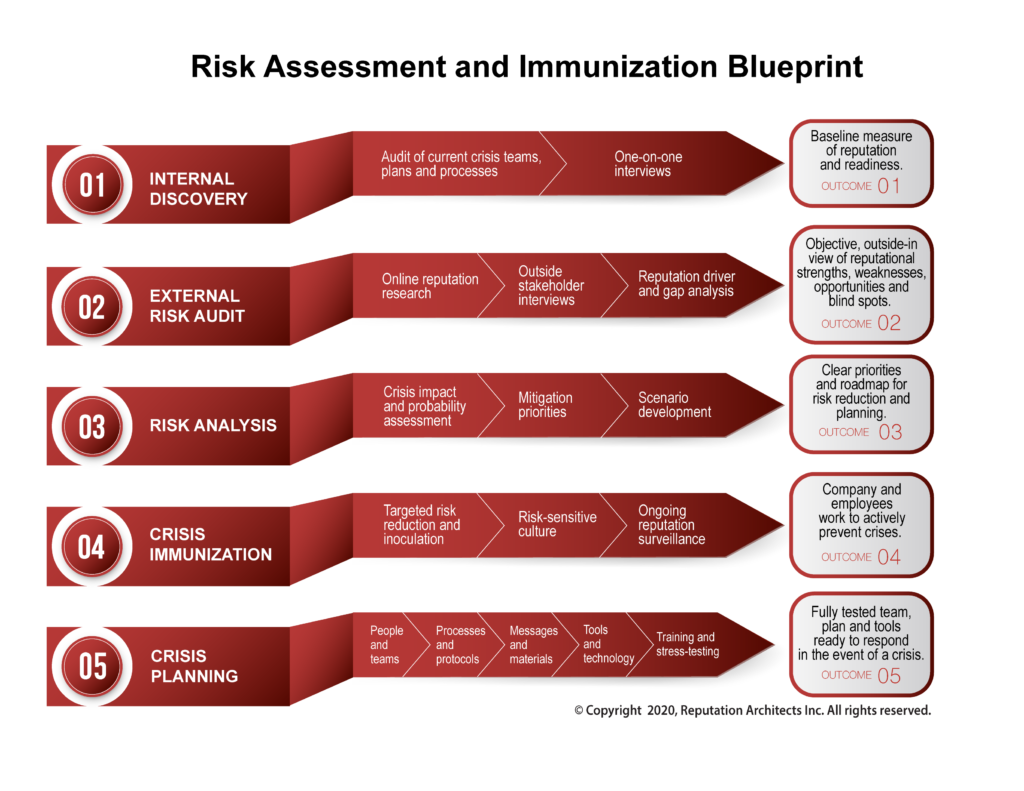There’s a reason companies offer generous preventative care benefits and even reward their workers for getting regular checkups and going to the gym—sick employees cost time and money. They know the investment they make to help workers stay healthy are paid back many times over through lower healthcare costs and employee turnover and a more engaged and productive workforce.
Crises burn time and money, too. Every hour managers have to spend dealing with an unexpected firestorm is time they’re not devoting to growth and other priorities. Now layer on the fees for lawyers and PR experts; possible fines and legal settlements; the hits to sales, stock price and reputation; and the litany of other tangible and intangible (not to mention unbudgeted) costs of a crisis. Leaders who say, “We have a plan and will deal with crises when they come,” are not only putting their businesses and stomach linings at risk. They’re resigning themselves to paying the bills for future disasters—in time, money and reputation—instead of working to avoid them. That’s a huge missed opportunity.
Time for a Risk Check-up
Think back to your last physical. You filled out a flurry of forms and answered a lot of questions about your overall health and past medical issues, your habits, the kind of work you do and your family history. You had a battery of tests and, if you’re of a certain age, maybe a “procedure” or two to probe for hidden problems. Going for a complete exam when we feel fine serves two purposes. First, it gives us a complete and accurate picture of our current health and the genetic, lifestyle and other risk factors that predispose us to future health issues. And, it can reveal any hidden issues we may already have brewing so we can nip them in the bud before they become more serious and difficult to treat. Understanding where we’re at risk empowers us to do simple things now, like eating more leafy greens or taking a daily blood-pressure pill, that can significantly reduce our odds of a heart attack or other sudden, life-threatening health crisis.
It’s the same for a company. A properly structured risk assessment performed by an objective third party does more than identify where and how an organization is predisposed to crises. It can also reveal areas of opportunity where taking simple steps like revamping antiquated policies or practices that are out of sync with society or enforcing safety guidelines that have fallen by the wayside can reduce or even eliminate the chances of a crisis down the road.
The process begins by looking internally at a company’s existing crisis teams, plans, processes and any systems it has to detect emerging issues so managers aren’t blindsided. One-on-one interviews with executives and experts throughout the organization explore what keeps them up at night and drills down into a long list of hazards, including:
- Emerging social, political, economic or demographic trends and how they might expose the company or its leaders to criticism.
- The potential for a product safety or service issue to corrode stakeholder trust and expose the company to litigation.
- Data security, privacy and technology-related risks.
- Reputational hazards arising from the company’s strategic alliances, marketing partnerships and other third-party relationships.
- HR threats, from labor disputes or discrimination allegations to employees whose personal activities create unexpected controversy for the company.
- Natural or man-made disasters that could damage vital facilities or cut off access to critical raw materials.
- How changes to a key regulation could impact the company’s costs and competitive position.
Next comes external research, including an analysis of online reputation, audits of traditional and social media and interviews with outside stakeholders. Coupled with the in-depth internal discovery, the result is a comprehensive, outside-in view of where the organization and its reputation are vulnerable to crisis, the reputational strengths and opportunities it can leverage and any weaknesses and blind spots it needs focus on as it works to build its crisis defenses.
Focus on the Right Threats
If you live in Florida, there’s a chance you could be eaten by an alligator. But you’d be a lot better off focusing on your risk of getting skin cancer than encountering a hungry reptile on the back nine. Likewise, a food manufacturer located near the end of a busy airport runway is far more likely to come under fire from customers sickened by a food-borne bug than have a plane crash into world headquarters. Determining which risks demand immediate attention and which can safely go on the back burner while more urgent hazards are being managed is essential.
Crisis impact and probability assessment does this by prioritizing a company’s risk exposures based on their relative likelihood and potential for harm. High-probability, high-impact risks—think food company and salmonella—move immediately to the front of the line for focused risk reduction and planning, while those deemed less probable and dangerous go to the end of the list.
The impact and probability assessment also identifies “low-hanging” risks that can be neutralized quickly and easily so they can be delegated to the proper area for action. Threats that will require more intricate planning or extensive resources to mitigate undergo additional layers of risk- and cost-benefit analysis to ensure they get the executive attention and budgets they deserve.
Build a Prevention Culture
Sadly, many of the crises organizations face today are self-inflicted. They happen because people make decisions without fully considering the risks, or because they fail to sense and respond to issues early, before they have a chance to coalesce into a full-blown crisis. Conventional wisdom says the best way to manage a crisis is to have a plan and be ready to respond, that’s not true. Fostering a culture in which employees at all levels are focused on managing risks and keeping crises from happening at all is even better.
Building a prevention culture means creating an environment in which employees instinctively look for and analyze risks as part of their day-to-day work and take those risks into account in their decision making. They understand the importance of acknowledging and acting on risks rather than sweeping them under the rug, see themselves as integral parts of a larger risk management system and feel motivated and responsible for actively safeguarding reputation.
When employees in a prevention culture see something, they say something. Here are three ways to get things moving in the right direction:
Communicate clear expectations and guidelines
Employees need to know what is expected of them when it comes to escalating risks and protecting reputation. In a strong prevention culture, employees take ownership of their own risks and those of their colleagues. They know how to sound a wider alarm when necessary, and the potential costs to the organization, their colleagues and themselves of not doing so.
Make risk management an integral part of planning and decision-making
No one ever wants to think about how the global product launch or bold new marketing campaign they are working on could careen off the rails. To preempt crises, give employees a simple, question-based rubric that encourages them to stop and carefully think through the risks of a particular decision or course of action before they proceed. Requiring managers to put larger projects through a more comprehensive and documented risk review process as a condition of budget approval is another good way to be ensure risks aren’t given short shrift.
Model sound risk management behaviors
Train managers to serve as risk management role models by being available, approachable and supportive when problems arise. The focus should be on ensuring that issues are properly addressed, not on pointing fingers or covering tracks. The time to analyze what happened, why, and who or what was responsible will come later. Recognize successes and use them to reinforce best practices. Use failures as a chance for the organization to learn and continually refine internal systems and controls.
In a post-pandemic world, organizations can’t afford not to look after their corporate and reputational health with the same diligence as their employees’ health. Solid preventative care is just a start, however. Practicing good hygiene, getting regular exercise, managing stress and insuring against major catastrophes are as important to building a healthy crisis immune system as they are to staying fit and avoiding serious health problems ourselves.
Join us next week as we continue our special series on Building Crisis Immunity with a look at five healthy habits for a stronger, more crisis-resistant reputation. And if you’re just joining us, be sure to check out our first installment, Why Crisis Immunization is the New Crisis Planning in a Post-Covid World.
# # #



Recent Comments